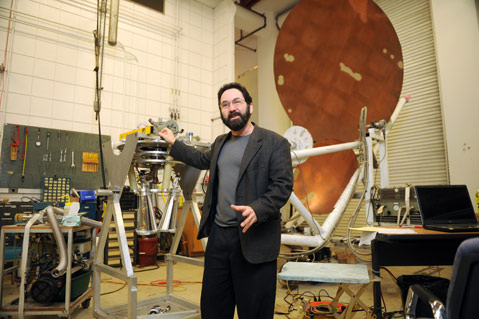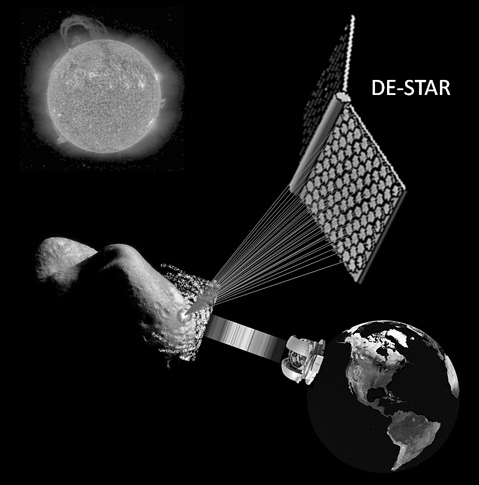Celestial Sharpshooter
UCSB Prof Unveils Plan to Keep Asteroids from Destroying Planet

Talk about ridiculous luck. Like any informed stargazer, UCSB physics professor Philip Lubin knew well in advance that a meteor half the size of a football field would be careening within 17,500 miles of Planet Earth last Friday. That made last week a shrewdly strategic time for Lubin — who normally spends his time trying to devise new ways to divine the exact age of the universe — to release the new white paper he’d been working on the past year detailing just how Homo sapiens can tap existing and emerging solar and laser technologies to zap incoming asteroids and meteors before they pose a threat.
But like the rest of the planet, Lubin was taken totally by surprise that a much smaller chunk of galactic rock would penetrate the Earth’s atmosphere the same day, exploding with the force of a strategic nuclear bomb over a small town in Siberia, blowing out window panes by the square mile and showering the countryside with shiny black pellets. The chances of the two events happening within the same span of 24 hours is, according to the experts, one in 100 million. Given the staggering audacity of what Lubin has in mind — not to mention the equally staggering cost — he’ll need such one–in–100 million events if his ideas are to gain traction.
Lubin is a careful, sober-speaking man, bordering on the somber. “For our discussion, that was not a ‘good thing,’” he cautioned, referring to the fast-flying space junk that exploded over Russia. “It was a wake-up call that there are things out there that could do us great harm.” One hundred years ago, he pointed out, a similarly sized asteroid struck Siberia, leveling 1,000 square miles in the process and wiping out 80 million trees. Sixty-five million years ago, it was a much bigger meteor with cataclysmic consequences; the dinosaurs were wiped out. “I don’t stay up nights worrying about this,” he said, “but there are threats. You don’t want to hide your head in the sand and pretend it doesn’t exist.”

NASA has already cataloged about 5,000 near-Earth objects, all larger than the one that just struck Russia. The smaller ones are more numerous; they’re also harder to detect. But they can be deadly. Had the Russian meteor exploded lower to the ground, a lot of people could have been killed. Instead, 1,200 were injured, mostly from flying glass shards. Still, Lubin noted, the explosion was bigger than any nuclear bombs contemplated by North Korea and Iran combined. “It was not a trivial distribution of energy,” he said. “And we had no idea it was coming.”
The first order of business, he said, is do a better job figuring out where the space junk is coming from. (NASA is giving the University of Hawai‘i $5 million to scan the heavens to do just that.) The second is to figure out how to bring it down. Or vaporize it. That’s where Lubin — along with his partner Gary Hughes of Cal Poly — comes in. They’ve proposed a system that they claim can take down a drifting body from as far away as Mars. “You don’t blow them up like Star Wars,” he said. “Our system is more like a magnifying glass on an ice cube. It evaporates it.” The asteroid that came within 17,500 miles of the planet, he said, could have been eliminated in a matter of two hours. “The one that hit Russia we could have taken out in a few minutes if we knew where it was.”
Lubin and Hughes are proposing a system they call DE-STAR, a somewhat tortured acronym standing for Directed Energy Solar Targeting of Asteroids and exploRation. In a nutshell, this entails launching solar panels and laser machines into orbit and using the sun’s energy to power the lasers to zap — vaporize — incoming galactic rocks and land masses hurtling through space to Earth. Lubin and Hughes have outlined six DE-STARs, each one significantly larger than the next. DE-STAR 0, for example, would be roughly one meter in size, cost a few million dollars to build and could be, Lubin said, put together today. A DE-STAR 4 — which is the minimum size for stopping meteors and asteroids — would occupy about six miles in space. The price tag for such an undertaking is beyond calculation, and the technology required has yet to evolve.
Lubin recognizes that many will dismiss his proposal as a Buck Rogers–Star Wars fantasy. “I like science fiction, but I don’t mix my science fact with my science fiction,” he said. “I’m a numbers person.” Much of the technology needed to realize this vision, he said, now exists in a tadpole stage; it just needs the time, the focus, and the investment to grow into a frog. The DE-STAR system is all about converting electrical energy into light. Incandescent lightbulbs, Lubin said, were notoriously inefficient, converting maybe 2 percent of the energy into light. Fluorescent bulbs, by contrast, enjoy energy efficiencies of 20-30 percent.
New LED technology has achieved efficiencies of 50 percent, all but unimaginable until relatively recently. And when combined with semiconductors, he said, LED technology can achieve greater efficiencies still. This revolution in photonics, Lubin said, will make possible his DE-STAR defense system. Powering all this will be an array of solar panels. Likewise, greater efficiencies must be achieved. But, he stressed, that’s already happening. Commercial solar panels have efficiencies of 12 percent; solar panels already in orbit have efficiencies of 40-50 percent; Lubin envisions technological leaps that enable efficiencies as high as 70 percent.
The biggest challenge, he stated, will be getting so much stuff into orbit and assembling it. By his metric, the Space Station would be comparable in size to a DE-STAR 2. Launching technology remains, he said, relatively primitive. But by harnessing the power of laser and light, he added, launch technology can be revolutionized to such an extent that a sizable spacecraft can be shot from Earth to Mars in a matter of weeks. In addition, he speculated that mining companies — long interested in the rare materials found on asteroids — could help defray some of the costs associated with such endeavors. None of this, he acknowledged, will happen within his lifetime. But it can happen, he added, within his children’s. “The technology is very expensive but rapidly getting better and cheaper,” he said. “It’s not the time to build a DE-STAR 4, but rather it is time for a serious discussion and start with a DE-STAR 0 or 1.”
Lubin, now in his fifties, is old enough to remember the duck-and-cover drills that Cold War kids practiced in preparation for possible nuclear attack. But instead of incoming missiles, he’s focused on incoming matter. “Someone’s throwing rocks at us. This time it’s nature,” he said. “Most of the time we dodge the bullet, but there are some big bullets out there.”
The problem is political as much as it is technical. “What we need is a common vision and a common enemy. Maybe we can see that enemy outside the Earth,” he said. Lubin expressed optimism that the United States could unify behind the DE-STAR program the way it did around the space program. As impressed as he was with that effort, Lubin said he recognized that many questioned its wisdom, given the abiding problems of poverty and racism. Such concerns, he said, resonated with him but ultimately proved unpersuasive. Such a quest, he said, has the ability to unify. “We lack a common vision and a desire to do the profound. We’re stuck squabbling over a piece of land or whose deity is the biggest, baddest deity. We should strive to do something grand and noble,” he said. “We can do that.”



